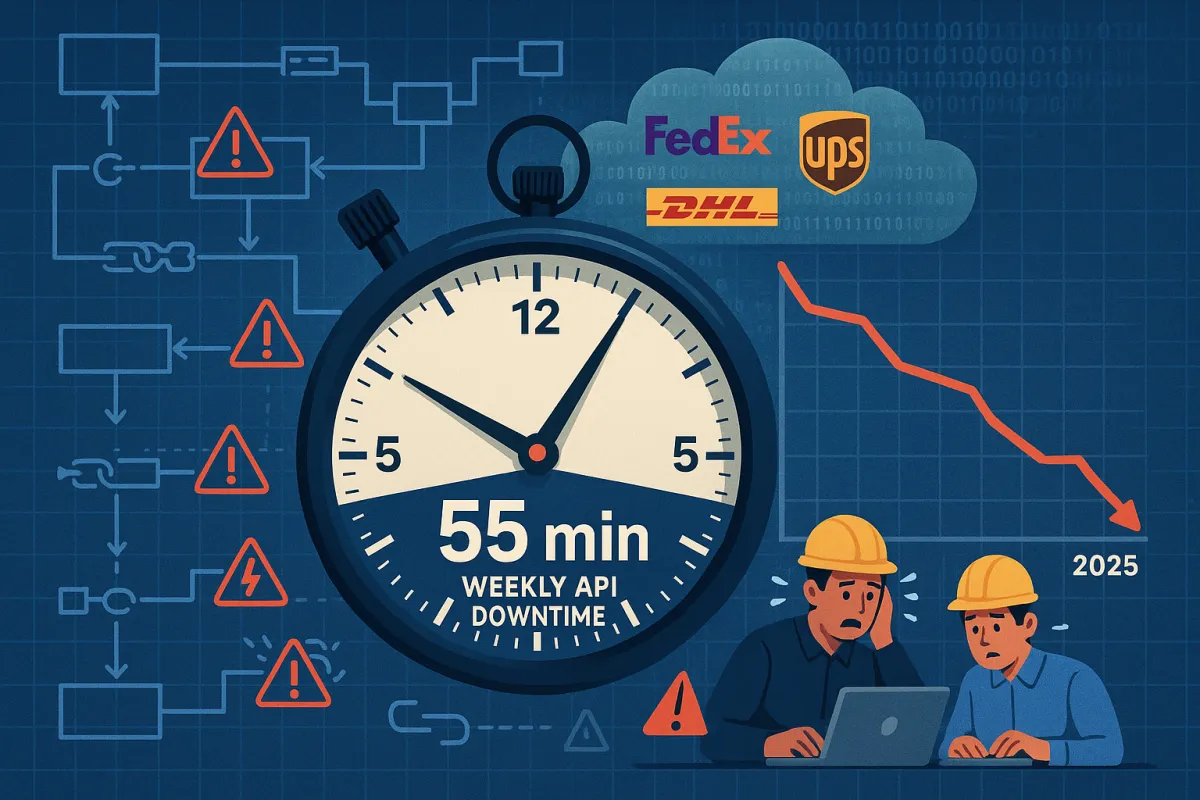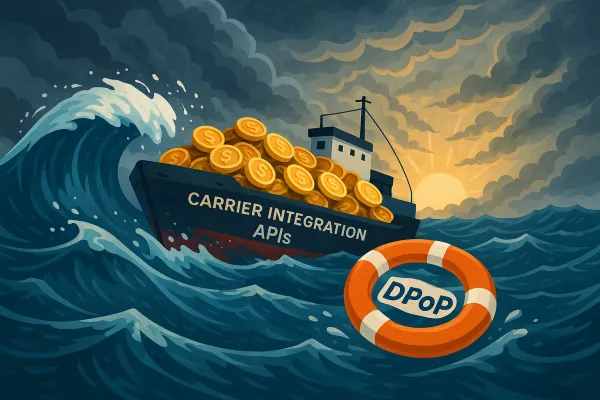Carrier API Reliability Crisis: 2025 Performance Data Shows 60% More Downtime

Weekly API downtime jumped from 34 minutes to 55 minutes year-over-year, while average API uptime fell from 99.66% to 99.46% between Q1 2024 and Q1 2025. That translates to 60% more downtime across more than 400 companies and 20 industries.
This isn't abstract industry chatter. While seemingly modest, this drop translates to an additional 90 minutes of downtime every month — during which e-commerce sites can't process purchases, mobile apps won't load, and critical business applications grind to a halt. For teams dealing with carrier integrations, that 55 minutes of weekly downtime now feels normal.
What's Behind the Performance Degradation
The root cause isn't mysterious. UPS is replacing its entire existing API infrastructure, while FedEx isn't just updating its API; it's championing a digital transformation. Both carriers had migration deadlines that got pushed back multiple times as companies struggled to adapt.
It was supposed to be May for FedEx and June for UPS. But both carriers have since moved their deadlines to August and September, which tells you what a challenge this has been for most shipper companies to comply with.
These weren't gentle upgrades. The previous access key-based authorization is being deprecated in favor of the more secure OAuth 2.0 security model, requiring a bearer token for every API request. From June 5, 2023, no new access keys will be distributed, and post-June 3, 2024, any transaction with UPS will mandate this new OAuth security model.
The Great API Migration Fallout
The migration timelines show why reliability suffered. Developers have until May 15, 2024 to adopt the improved FedEx API, at which point previous SOAP APIs will become completely inaccessible. For UPS, any prior integrations, be it XML, SOAP, or legacy JSON payloads, will necessitate a complete transformation to align with UPS's RESTful APIs from their new API Catalog.
The complexity caught many integration teams off-guard. Many shipper companies still don't seem to have gotten the memo that complying with FedEx's and UPS's new API access requirements isn't going to be quick or easy. That's why it's important to let companies know that they can't wait until the last minute to begin upgrading and/or converting their technologies.
Timeout and Rate Limiting: The New Normal
Rate limiting has become more aggressive as carriers struggle to manage traffic during transitions. API Rate Limiting is critical for managing traffic, protecting resources, and ensuring stable performance. But implementation varies wildly.
The 429 status code has become painfully familiar. Handling rate limit errors effectively involves returning clear and informative error messages, such as an HTTP 429 status code, along with a Retry-After header that indicates when the user can try again. Giving users tips on how to avoid hitting rate limits in the future, such as by optimizing their API calls or upgrading to a higher service tier, can also improve their experience.
Best practices exist, but carriers aren't consistently following them. Understand Traffic Patterns: Analyze peak usage times, request frequency, and growth trends to set appropriate limits. Choose the Right Algorithm: Use algorithms like Fixed Window, Sliding Window, Token Bucket, or Leaky Bucket based on your API's needs. The token bucket approach works well for carrier APIs because implementing the token bucket algorithm ensures a balance between burstable traffic and steady throughput. This approach allows users to accumulate tokens over time, granting flexibility for unexpected spikes. For instance, if the limit is set at 60 requests per minute, a user could burst up to 10 requests at once if they have enough tokens stored.
Performance Benchmarks by Carrier Type
Direct carrier APIs show concerning patterns when you dig into the numbers. Response times vary dramatically by industry, with many of these businesses rely on fragmented systems, aging infrastructure, and a mix of internal and third-party services across regions. These complexities make it difficult to maintain consistent uptime, fast response times, and rapid issue resolution.
The monitoring reveals stark differences. It involves tracking key metrics such as response time, latency, error rates, and overall operational health to ensure communication between software applications. Response time matters more than you think — One of the most basic and fundamental metrics in API monitoring, Uptime is a golden standard in measuring the performance of any service. You might have heard the term 99.999% uptime, which is a measure of how many uptimes vs downtimes there are per year.
Multi-carrier platforms are stepping up as direct APIs struggle. Companies like EasyPost, nShift, Cargoson, and ShipEngine build redundancy into their systems that individual carriers can't match.
Practical Solutions for Integration Teams
Start with proper retry logic and exponential backoff. Use Dynamic Rate Limits: Implement dynamic rate limits that can adjust based on server load or user behavior, helping to maintain performance during unexpected traffic spikes. Monitor User Activity: Keep an eye on how users are interacting with your API. Monitoring tools can help you detect patterns that might indicate abuse or excessive use, allowing you to adjust limits accordingly.
Circuit breaker patterns prevent cascading failures when carrier endpoints go down. The pattern works like this: track error rates and response times, automatically stop making requests when thresholds are exceeded, and periodically test if the service has recovered.
Multi-carrier failover requires strategic thinking. Build logic that automatically switches between UPS, FedEx, DHL, and regional carriers when one becomes unavailable. Platforms like EasyPost, ShipEngine, Cargoson, and nShift handle this complexity for you, but direct integrations need custom fallback logic.
When choosing between aggregators and direct integrations, consider your volume and complexity. High-volume operations with custom requirements might justify direct carrier integrations despite the reliability challenges. Smaller operations benefit from aggregator platforms that smooth over carrier-specific issues.
Monitoring and Alerting Setup
Essential metrics go beyond simple uptime checks. Middleware lets you set smart alerts based on response time and the response code of API. Track response times, error rates, and timeout patterns for each carrier endpoint.
Set alerting thresholds based on business impact rather than arbitrary numbers. A 5-second response time might be acceptable for address validation but catastrophic for label generation during peak shipping hours.
Also, having a detailed breakdown of network timing data and response time by location helps with faster root cause analysis. Each API's performance impacts the service and application performance, so monitoring metrics like the number of requests, error and success rate and latency is very important.
Tools matter less than consistent measurement. Whether you use Datadog, New Relic, or open-source alternatives like Prometheus, the key is tracking trends over time and correlating outages with business metrics like failed label generations or delayed shipments.
The reliability crisis won't solve itself. Integration teams need proactive monitoring, intelligent retry logic, and fallback strategies to navigate this new normal. Multi-carrier platforms offer one path forward, while direct integrations require more sophisticated error handling than ever before.




